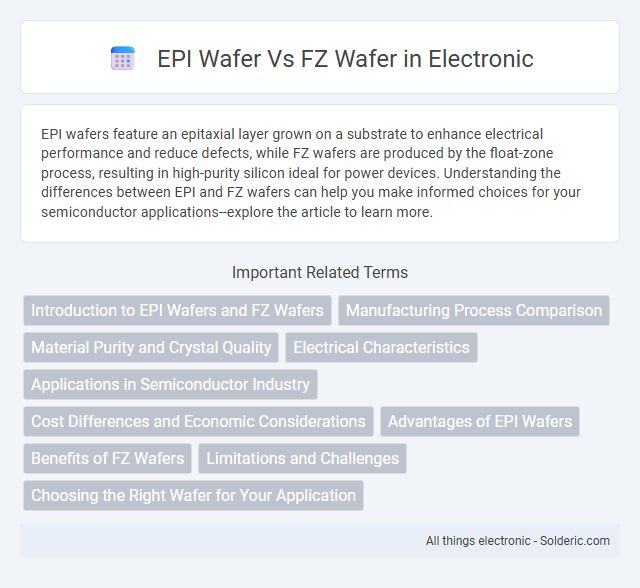EPI wafers feature an epitaxial layer grown on a substrate to enhance electrical performance and reduce defects, while FZ wafers are produced by the float-zone process, resulting in high-purity silicon ideal for power devices. Understanding the differences between EPI and FZ wafers can help you make informed choices for your semiconductor applications--explore the article to learn more.
Comparison Table
| Feature | EPI Wafer | FZ Wafer |
|---|---|---|
| Full Name | Epiphyte Wafer | Float Zone Wafer |
| Manufacturing Process | Silicon layer grown on Czochralski substrate | Zone refining of silicon rod without crucible |
| Purity | Lower than FZ, contains oxygen | Higher purity, oxygen-free |
| Resistivity | Low to medium resistivity | High resistivity, up to several kilo-ohm-cm |
| Defects | Oxygen-related defects due to CZ substrate | Minimal oxygen defects, fewer impurities |
| Applications | Power devices, CMOS, MEMS | High-frequency devices, high-voltage power devices, radiation detectors |
| Cost | Lower cost | Higher cost due to complex process |
| Thermal Stability | Moderate | High thermal stability |
Introduction to EPI Wafers and FZ Wafers
EPI wafers feature a thin, lightly doped epitaxial silicon layer grown on a heavily doped silicon substrate, enhancing device performance by improving layer uniformity and reducing defects. FZ wafers, or float zone wafers, are created through a crucible-free zone melting process, resulting in ultra-pure, high-resistivity silicon ideal for high-performance semiconductor applications. Both wafer types serve distinct roles in semiconductor manufacturing, with EPI wafers favored for integrated circuits and FZ wafers preferred for advanced power and high-frequency devices.
Manufacturing Process Comparison
EPI wafers are produced by depositing a thin, high-purity silicon layer on a substrate using chemical vapor deposition (CVD), exhibiting precise control over doping concentration and layer thickness. In contrast, FZ wafers are manufactured by melting and recrystallizing high-purity silicon using the floating zone method, which eliminates contamination from crucibles and results in ultra-high resistivity and purity. The EPI process is most suitable for applications requiring tailored surface properties, whereas FZ wafers excel in high-performance device fabrication due to their superior bulk crystal quality.
Material Purity and Crystal Quality
Epitaxial (EPI) wafers exhibit superior material purity due to the controlled deposition process that layers high-purity silicon atop a base wafer, reducing contamination and defects. Float Zone (FZ) wafers are renowned for exceptional crystal quality, featuring minimal oxygen content and low dislocation density achieved through a zone refining melting technique. Both wafer types are critical in semiconductor manufacturing, with EPI wafers preferred for advanced device fabrication and FZ wafers favored for high-power and high-frequency applications due to their intrinsic purity and crystal integrity.
Electrical Characteristics
EPI wafers exhibit lower defect densities and improved uniformity, resulting in enhanced minority carrier lifetimes and higher breakdown voltages compared to FZ wafers. FZ wafers typically demonstrate superior resistivity and lower oxygen content, which contribute to better leakage current performance and reduced carrier recombination rates. Both wafer types impact device efficiency and reliability, with EPI wafers preferred for high-frequency applications and FZ wafers favored in high-power, high-resistivity semiconductor devices.
Applications in Semiconductor Industry
EPI wafers, characterized by a thin epitaxial layer grown on a silicon substrate, are widely used in the fabrication of high-performance integrated circuits, power devices, and advanced CMOS technologies due to their superior electrical properties and low defect density. FZ wafers, produced via the float zone process, offer ultra-high purity and low oxygen content, making them ideal for high-power devices, radiation detectors, and specialized applications requiring exceptional semiconductor crystal quality. Both wafer types enable enhanced performance in semiconductor devices, but EPI wafers dominate in digital and analog circuits, while FZ wafers are preferred in power electronics and high-frequency components.
Cost Differences and Economic Considerations
EPI wafers generally cost more than FZ wafers due to the additional epitaxial layer deposition process, which increases manufacturing complexity and time. FZ wafers offer a more economical option with high purity and fewer defects, making them ideal for high-performance and cost-sensitive applications. Your choice between EPI and FZ wafers should consider budget constraints alongside performance requirements, as the higher cost of EPI wafers may be justified only when superior layer quality is essential.
Advantages of EPI Wafers
EPI wafers offer superior surface uniformity and epitaxial layer control compared to FZ wafers, enhancing device performance in high-frequency and power applications. Their reduced defect density and enhanced electrical properties improve yield and reliability for semiconductor manufacturing. You benefit from improved device scalability and integration when choosing EPI wafers for advanced electronic components.
Benefits of FZ Wafers
FZ wafers offer superior purity and electrical performance due to their float-zone refining process, which eliminates contaminants more effectively than EPI wafers. These wafers exhibit higher carrier lifetimes and lower oxygen content, making them ideal for high-power and high-frequency semiconductor devices. Your devices benefit from enhanced reliability and efficiency when utilizing FZ wafers in advanced applications.
Limitations and Challenges
EPI wafers face limitations such as higher defect density and potential for wafer bowing due to the epitaxial layer, which can affect device yield and performance consistency in high-precision semiconductor manufacturing. FZ wafers exhibit challenges including higher production costs and lower availability, as float zone refining is less scalable than Czochralski methods, making them less accessible for large-volume applications. Your choice between EPI and FZ wafers depends on balancing these trade-offs in defect control, wafer flatness, and cost-efficiency for your specific semiconductor fabrication needs.
Choosing the Right Wafer for Your Application
EPI wafers provide a high-quality epitaxial layer ideal for advanced semiconductor devices requiring excellent electrical performance and uniformity, while FZ wafers offer superior purity and fewer crystal defects, making them suitable for high-power and high-frequency applications. Your choice depends on the specific requirements of your application, such as the need for defect-free substrates or enhanced device reliability. Selecting the appropriate wafer type ensures optimal performance and yield in your semiconductor manufacturing process.
EPI wafer vs FZ wafer Infographic

 solderic.com
solderic.com